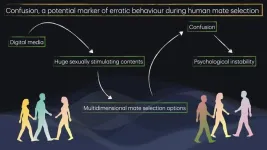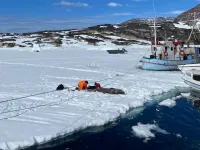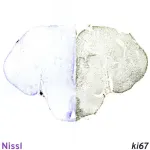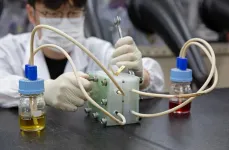(Press-News.org) France’s natural history collections contain nearly 6% of the world’s total natural specimens across multiple institutions, and the e-COL+ project aims to capture and reconstruct these specimens in 3D for easy access and 3D printing around the world.
“I’m a researcher of vertebrate locomotion and vocalisation, so I produce a lot of CT scans and 3D models – and now I’m in charge of developing the museum’s own 3D digital collection,” says Dr Pauline Provini, a lecturer at the Natural History Museum in Paris, France and collaborator on the e-COL+ project. Dr Provini is in line to become the Scientific and Technical Coordinator for the project, following the announced retirement of the current Coordinator Pierre-Yves Gagnier.
Dr Provini and her partners plan to produce several thousands of 3D models of whole animal specimens and fragmental specimens, which includes bones and partial remains. The e-COL+ project is led by France’s National Natural History Museum and includes 9 other national research institutions and universities.
The e-COL+ project has four main objectives. Firstly, to provide modern equipment, especially 3D scanning tools, to the partcipating project partners so that they can digitise their collections.
Secondly, to create a comprehensive dataset of 3D models of animals that cover a wide range of taxonomy, including both living and extinct species. “We want to have digital versions of representatives of most modern vertebrates and arthropods,” says Dr Provini. “We also want to incorporate any existing 3D models from the French collections and help to fill the gaps.”
Depending on the size and type of the specimen, Dr Provini and her team use different scanning techniques. “We use surface scanners for bones and whole skeletons, but we use CT scans for specimens that are kept in fluid,” she says. “For small specimens like insects, we use external providers like the European Synchrotron Radiation Facility.”
Thirdly, they wish to build AI tools to help improve the 3D model reconstruction process. “This can help with the automatic identification of a species or the parts of the specimen, which is a very important development for the project,” says Dr Provini.
The fourth and final objective is to organise storage, availability, and presentation of the digital models for both research and public use. “We want to build an online 3D catalogue that people can use to download the models. Not only researchers, but also more general audiences,” says Dr Provini.
A major benefit of this project is the ability to rapidly share access to specimens between research institutions and other museums around the world. “Typically, institutions can borrow specimens from other places for their own exhibitions, but it can be very complicated because there's a lot of paperwork to do – especially if they’re very rare or fragile specimens,” says Dr Provini. “Now we just send the numerical model, and they can 3D print the model whenever they want.”
The e-COL+ project also has benefits for teaching by providing access to specimens that may otherwise be restricted. “It will be important for learning anatomy and other subjects, but also useful for learning to use 3D printing technology and software," says Dr Provini.
The e-COL+ project is set to conclude in 2029. It is funded by the French government and managed by the French National Research Agency under the Programme d'Investissements d'Avenir (ANR-21-ESRE-0053).
This project is being presented at the Society for Experimental Biology Annual Conference in Prague on the 2-5th July 2024.
END
Meet the team 3D modelling France’s natural history collections
2024-07-03
ELSE PRESS RELEASES FROM THIS DATE:
Artificial light is a deadly siren song for young fish
2024-07-03
New research finds that artificial light at night (ALAN) attracts larval fish away from naturally lit habitats, while dramatically lowering their chances of survival in an “ecological trap”, with serious consequences for fish conservation and fishing stock management.
“Light pollution is a huge ongoing subject with many aspects that are still not well understood by scientists,” says Mr Jules Schligler, a PhD student at CRIOBE Laboratory (Centre de Recherches Insulaires et Observatoire de l’Environnement) in Moorea, French Polynesia.
ALAN is the product of human-related ...
Social media is a likely cause of ‘confusion’ in modern mate selection
2024-07-03
A recent sociological study finds that most young adults surveyed reported feeling confused about their options when it comes to dating decisions. Preliminary analysis suggests that more than half of young people experience confusion about choosing life-partners, with women appearing to be more likely to report partner selection confusion than men.
Due to the pervasiveness of social media and digital dating in everyday lives, humans are now exposed to many more potential mates than ever before, but the availability of popular dating apps ...
Exploring bird breeding behaviour and microbiomes in the radioactive Chornobyl Exclusion Zone
2024-07-03
New research finds surprising differences in the diets and gut microbiomes of songbirds living in the radiation contaminated areas of the Chornobyl Exclusion Zone, Ukraine. This study is also the first to examine the breeding behaviour and early life of birds growing up in radiologically contaminated habitats.
The Chornobyl Exclusion Zone (Ukrainian), also known as the Chernobyl Exclusion Zone (Russian), is an area of approximately 2,600 km2 of radiologically contaminated land that surrounds the Chornobyl Nuclear Power Plant. The levels of contamination are uneven throughout the zone.
“The ...
Discovering new anti-aging secrets from the world’s longest-living vertebrate
2024-07-03
New experimental research shows that muscle metabolic activity may be an important factor in the incredible longevity of the world’s oldest living vertebrate species – the Greenland shark. These findings may have applications for conservation of this vulnerable species against climate change or even for human cardiovascular health.
Greenland sharks (Somniosus microcephalus) are the longest living vertebrate with an expected lifespan of at least 270 years and possible lifespan beyond 500 years. “We want to understand what adaptations ...
Pregnant fish can also get “baby brain”, but not the way that mammals do
2024-07-03
New research reveals that pregnancy-related brain impairment is present in live-bearing fish, but instead of affecting learning and memory as expected from similar research on mammals, it appears to have a stronger impact on decision-making and sensory reception.
There have been many studies into the detrimental impact of pregnancy on mammalian brains, sometimes called “baby brain” or “momnesia” in humans, revealing how the disruption of neurological processes like neurogenesis, or the creation ...
Pasteurization inactivates highly infectious avian flu in milk
2024-07-03
Highlights:
• In late March 2024, H5N1 bird flu was detected in dairy cattle and then in raw milk.
• Researchers tested hundreds of milk products from dozens of states for the virus.
• No infectious virus was found in pasteurized milk products.
• Non-infectious traces of viral genetic material were found in 20% of samples.
Washington, D.C.—In March 2024, dairy cows in Texas were found to be infected with highly pathogenic avian flu, ...
KIER develops 'viologen redox flow battery' to replace vanadium’
2024-07-03
A technology has been developed to replace the active material in large-capacity ESS 'redox flow batteries' with a more affordable substance.
*Redox Flow Battery: A term synthesized from Reduction, Oxidation, and Flow. It is a battery that stores electrical energy as chemical energy through oxidation and reduction reactions of active materials in the electrolyte at the electrode surface and converts it back to electrical energy when needed. It is capable of large-scale storage, can be used long-term through periodic replacement of the electrolyte, and its major advantage is the absence of fire risk.
Dr. Seunghae Hwang’s ...
Chemists synthesize an improved building block for medicines
2024-07-03
Chemists have overcome a major hurdle in synthesizing a more stable form of heterocycle—a family of organic compounds that are a common component of most modern pharmaceuticals.
The research, which could expand the toolkit available to drug developers in improving the safety profiles of medications and reducing side effects, was published in Science by organic chemists at the University of British Columbia (UBC), the Massachusetts Institute of Technology (MIT), and the University of Michigan.
“Azetidines ...
A genetic algorithm for phononic crystals
2024-07-03
Tokyo, Japan – The advent of quantum computers promises to revolutionize computing by solving complex problems exponentially more rapidly than classical computers. However, today's quantum computers face challenges such as maintaining stability and transporting quantum information. Phonons, which are quantized vibrations in periodic lattices, offer new ways to improve these systems by enhancing qubit interactions and providing more reliable information conversion. Phonons also facilitate better communication ...
Machine learning could aid efforts to answer long-standing astrophysical questions
2024-07-03
In an ongoing game of cosmic hide and seek, scientists have a new tool that may give them an edge. Physicists at the U.S. Department of Energy’s (DOE) Princeton Plasma Physics Laboratory (PPPL) have developed a computer program incorporating machine learning that could help identify blobs of plasma in outer space known as plasmoids. In a novel twist, the program has been trained using simulated data.
The program will sift through reams of data gathered by spacecraft in the magnetosphere, the region of outer space strongly affected by Earth’s ...






